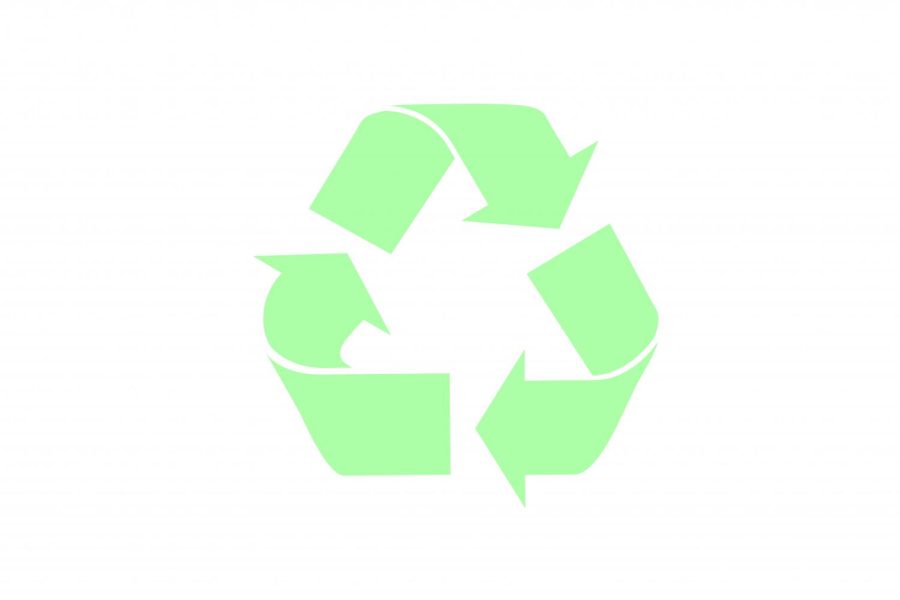Recycling efforts are ending up in the trash
Graphic illustration by InDepth Section
Items go in recycling bins and disappear, supposedly given a new life as another product and reducing the environmental damage caused by trash.
January 29, 2020
Items go in recycling bins and disappear, supposedly given a new life as another product and reducing the environmental damage caused by trash. In reality, many of these items, if not recycled correctly, end up in landfills.
Recycling tries to repurpose items and reduce the amount of waste that goes into landfills. However, materials that can be considered recyclable have continued to end up in landfills due to contamination and economic reasons.
The practice of recycling is not new to Americans, but many misunderstand the process by which materials are repurposed. Most of the U.S. uses a system called single-stream recycling, in which consumers place all types of recyclables, including plastic, paper, glass and metal, into a curbside bin. From there, the recyclables are transported to a materials recovery facility where they are sorted by both people and machines.
By improperly sorting materials consumers complicates the sorting processes and reduces the amount of usable recyclable material. Items that contain residue, such as greasy pizza boxes, can contaminate whole truckloads of recycling, making them unusable for recycling. In the U.S., the amount of contaminated recycling has increased over the years, from 12 percent in 2010 to 25 percent in 2018.
“It’s important to throw out the correct materials in the correct trash bins,” said Conservation Action Association (CAA) officer junior Danielle Lowe. “I know that some teachers have specific bins for cans and other bins for paper, but sometimes they are not labeled clearly so students might put the materials in incorrect bins, which ends up contaminating everything in there.”
Another issue in the process is that recycling facilities stockpile materials such as cardboard outside to process later, which can be easily damaged by weather and the sun, forcing the facilities to throw them out into landfills.
Facilities may also find that recycling certain materials causes them to lose money. For example, the cost to recycle glass is greater than its market value. As a result, some recycling centers have even stopped accepting glass. In 2017, the Environmental Protection Agency reported that 11.3 million tons of glass were generated in the U.S., but only 3 million tons were recycled.
After local recycling facilities collect and sort the materials, the bales of recycling must be sent to reclaimers that remake scrap material into new material. The U.S. recycling industry heavily depends on China for this, but as of January 2018, China has tightened its restrictions on the quality of the materials which means recycling facilities in the U.S. must find new markets for their goods. Domestically, U.S. infrastructure is not built to handle all the country’s recycling. These issues lead to recycling centers closing down because they cannot sell their materials to generate enough revenue to stay open.
However, even when the U.S. was selling its recycling to China, not all of the material sold was repurposed. In fact, only 25 percent of certain low-quality bales of plastic could be recycled, while the rest was burned or sent to landfills. Sending the materials to China had given Americans the illusion of recycling: a large amount of the waste actually ended up in landfills.
“I think it’s actually beneficial to [the U.S.] that we don’t export to China because that makes us do something about our problem in America, and not push the problem onto other countries,” said Conservation Action Association officer senior and CAA officer Chap-Lum Lau. “It might have some economic setbacks, but in the long term I think that it would be better for our environment.”
On the consumer level, people can be more mindful of what items they are tossing in the recycle bin. Organizations such as San Jose Recycles help consumers determine which items they can recycle and where certain items, such as plastic bags and films, should go. In general, containers should be cleaned of food and liquids before they are put in recycling bins to prevent contaminating entire loads of recycling.
“There’s a lot of logistics of what you can recycle so a lot of people have misconceptions about it. [One should] make sure the things that you’re recycling are clean, more or less, or else the whole thing has to go to the garbage,” Lau said.
Aspirational recycling — which occurs when one is unsure whether to recycle an item and decides to recycle it anyway out of the belief that they are doing something good for the environment — plays a role in decreasing the effectiveness of recycling. In addition, properly separating the two types of waste are an important step to increasing the effectiveness of recycling.
“What [my students] are finding is that people are not paying a lot of attention to the difference between the regular garbage can and recycling can, so there’s lots of garbage in the recycling cans,” said David Herz, an Academic Community and Transition teacher who helps students recycle cans and bottles. “They have to actually pull the recyclable materials out of the garbage and then dump the garbage into a garbage can.”
As the trash piles up on planet Earth, it is important to know about managing and reducing waste. While recycling can be a way to reduce the growth of landfills, there are limits and rules to know in order to do it effectively.





























































